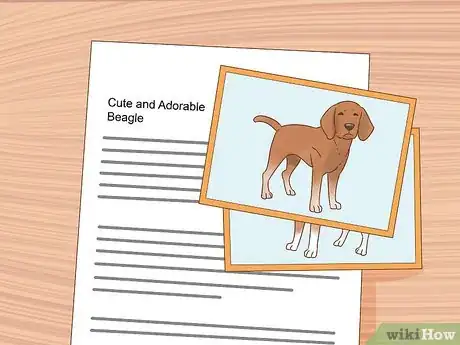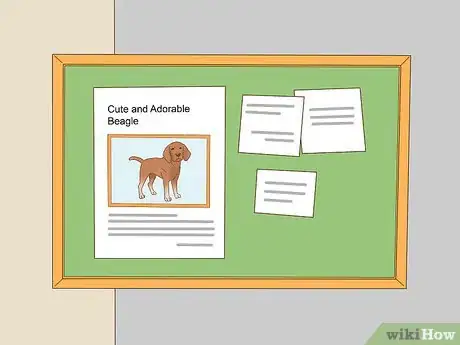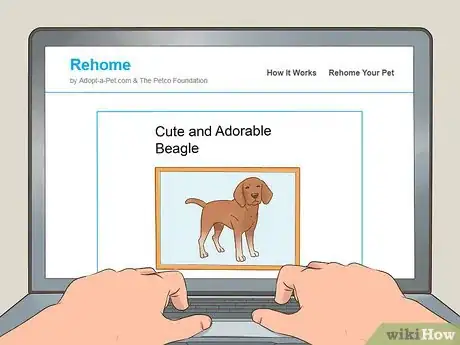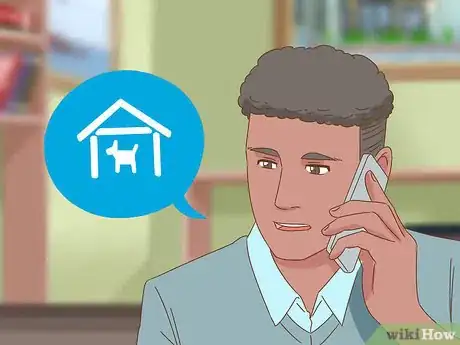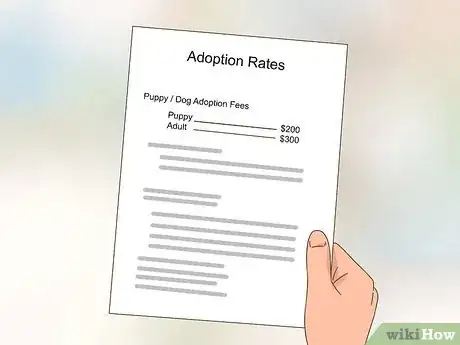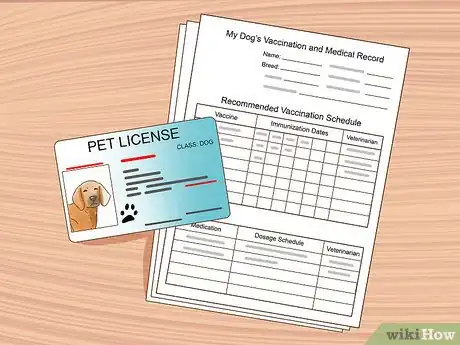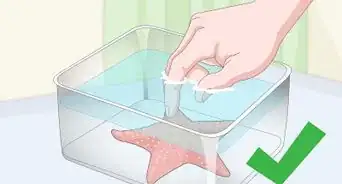This article was co-authored by Jennifer Damon. Jennifer Damon is a Professional Dog Trainer and the Owner of Love for Paws Dog Training in Richmond, VA. With over 10 years of experience training dogs, Jennifer specializes in determining the psychology that motivates dog behavior. As a supporting member of the International Association of Animal Behavior Consultants, Jennifer is passionate about improving the communication between owners and their pets through gentle, scientifically-backed methods. She holds a BFA in Communication Arts from the University of Montevallo and a Certificate in Canine Behavior Consulting from The International College of Canine Studies.
This article has been viewed 56,729 times.
If a personal hardship, change in living situation, or other issues make it necessary to give up your pet, finding it a good home is your most important concern. You will want your animal to have a stable environment with a caring new owner. By putting your pet’s best paw forward, getting the word out, and carefully evaluating possible new homes, you can make sure that your pet will be happy and healthy with its new family.
Steps
Getting the Word Out
-
1Present your pet at its best with a nice photo and engaging description. You should include details about your pet’s personality, its likes and dislikes, and why it would make a good addition to someone’s family. Keep in mind that pets are more likely to be adopted quickly if they are spayed or neutered and up to date on vaccinations.[1]
- Bathe and groom your pet before taking photos so that it looks as attractive as possible.[2]
- Be honest about any of your pet’s major shortcomings. If you aren’t, your pet might get rehomed by the adopter, without you there to make sure that it gets a good home. This information should be included in the description in case it is a deal breaker for potential adopters.[3]
- It is also important to disclose any medical problems or behavioral issues. You want to make sure that any potential adopter is aware of likely financial responsibilities and that they have the necessary resources to handle them.[4]
-
2Start by telling people you are looking for a new home for your pet. The best home for your pet is with a trusted family member or friend who may already be familiar with your pet, so ask them if they are interested. Also, people are more likely to take a dog from someone they know who is in need. You can also check with your coworkers or fellow pet owners you may know from the dog park.[5]
- When approaching people, you could say: “I’m looking for a new home for Fido, and I’ve noticed how well you two get along. Would you be interested in adding a new dog to your family?”
- If someone turns you down, react graciously and ask if they may know of someone who is looking for a new pet: “Thank you for being up front with me about not being able to take on another pet right now. Can you think of anyone who might be looking for a pet and would be a good fit for Fido?”
- It is also a good idea to check with your veterinarian and groomer. They may be aware of someone who can adopt your pet.[6]
Advertisement -
3Make flyers and post them where people will see them. Use the photo and profile that you wrote. There are often community bulletin boards in coffee shops, grocery stores, libraries, and churches where you can post your flyer.[7]
- You may also be able to post your flyer in veterinary offices, pet stores, and your workplace.
-
4Post your pet’s profile online to reach a wide audience. Websites like http://getyourpet.com and http://rehome.adoptapet.com focus on helping pet owners find new homes for their pets.[8] You can also post about your pet on your social media accounts and ask your friends to share your posts.[9]
- Some shelters and rescues may be willing to post your pet’s profile on their websites. Contact your local shelter and rescues to ask if they would be able to do this for you.[10]
-
5Contact a local animal shelter or rescue as a last resort. You will probably need to make an appointment to surrender your pet. Be aware that you may need to pay a surrender fee (typically $30-$50).[11]
- Research the shelter beforehand by looking up online reviews, talking to people who have adopted animals from the shelter, and if possible, visiting in person.[12]
- When scheduling your appointment, ask about a surrender fee or any other requirements so that you are prepared.
- If you have a purebred animal, there may be breed-specific rescues you can contact.
- It's also a good idea to make a donation to the rescue that is rehoming your pet.
Evaluating Potential New Homes
-
1Screen candidates over the phone to see if they seem responsible. It is a good idea to gauge the potential adopter’s experience with animals by asking if they have had a pet before and what happened to it. You can also ask how long they have been considering adding a pet to their family to make sure it is a thoughtful decision.[13]
- If the caller is a child or teenager, ask to speak to an adult in the household. If the person seems young, ask if their situation is stable or if they will be going to college, moving soon, or entering the military.
- Ask if the pet is for them or a gift for someone. In general, gifting pets is not a good idea, especially if it is to a child. Pet ownership involves a lot of responsibility, and the pet’s new owner should be involved in the decision to take that on.
-
2Meet promising candidates to assess them in person. Keep your tone conversational, and emphasize you are interviewing them because you want to find a good home for your pet.[14] Ask what the potential adopter is looking for in a pet and what their deal breakers are to check if it is a good fit.[15]
- The potential adopter should seem confident that they can provide your pet with a good home, and they should have a realistic view of the responsibilities of pet ownership. A good way to gauge this is to ask how they plan to care for your pet on a day-to-day basis.
- Ask for references who would have insight into the adopter as a pet owner. This could be a veterinarian, landlord, or neighbors. Other possibilities include someone the potential adopter has pet sat or walked dogs for.[16]
-
3Evaluate your pet’s potential new family. Ask whether the potential adopter has children and how old they are. You should ask about other pets in the potential adopter’s home and how they get along with other animals.[17]
- Children under six are not a good fit for a young animal because the child may treat the animal roughly and it will react badly. An adult animal is usually more tolerant of small children and may have experience with them.
- Keep in mind that even if potential adopters don’t have children of their own, they might have grandchildren who visit regularly.
- Consider your pet’s personal temperament around other pets and children.
- If there are other animals in the home, ask about the potential adopter’s plan for introducing the animals to each other.[18]
-
4Assess your pet’s potential new home environment. If you feel comfortable doing so, ask if you can see where your animal will be living. This will give you a chance to see the other animals in the home and how they are cared for.[19]
- If the potential adopter rents, confirm that their lease allows pets and that there aren’t breed or size restrictions that would affect your pet. You may want to ask for their landlord’s contact information so that you can verify this for yourself.
- For cats, ask whether they will be keeping it indoors or outdoors. Outdoor cats have much shorter life spans due to traffic accidents and other mishaps.
- For dogs, ask how many hours it will be alone during the day. If it is for long periods, check if the potential adopter can make arrangements for a dog walker or doggie daycare.
-
5Introduce the best candidate to your pet to see if it is a good fit. Observe how the potential adopter relates to your pet and how your pet interacts with the potential adopter.[20] Try to meet everyone who will be living with your pet, including other animals.[21]
- Only meet with the adopter in your home if you feel comfortable doing that. Otherwise, you could meet in a neutral, relaxing environment for your pet like a dog park or on a walk around the neighborhood.
- Keep in mind that your pet may be shy at first around the new person. If that is the case, a good potential adopter will react in a sensitive manner and remain calm and reassuring.
- The potential adopter should be patient with your pet and seem comfortable with it. Watch to make sure that they are handling your pet correctly.
-
6Charge an adoption fee to ensure the adopter is serious. Pet ownership isn’t something to be taken lightly, and the adopter should be willing to take on the financial responsibilities. If you’d rather not charge an adoption fee, you could ask them to make a donation to a local animal shelter.[22]
- You may wish to waive the adoption fee if your pet is being adopted by a family member or close friend.
Ensuring a Smooth Transition
-
1Gather all of your pet’s records and give them to the new owner. This could include dog licenses and vaccination or medical records. It is also a good idea to provide contact information for your veterinarian.[23]
- If you pet has any food sensitivities or allergies, you should provide this information to the new owner in writing.
-
2Send your pet to its new home with its favorite things. This could be a dog bed, blanket, or toys. These items will have familiar scents and will help your pet feel comfortable in its new environment.[24]
- Consider spraying the items with a pheromone spray that can help relieve anxiety. These can be purchased at your local pet store.
- If your pet’s new owner needs them, you can also pass along items like leashes, food bowls, and pet food.
-
3Ask the adopter if you can call to check in a few weeks. This will give you peace of mind about how your pet is doing in its new home. You also may be able to help address any issues if your pet is not adjusting well.[25]
- Once you have adequate reassurance that your pet is well cared for, it is time to let go. You don’t want to bother the new owners, and you want your pet to successfully acclimate to its new home and bond with its new family.
- It is okay to grieve. Remember that you have done the best you can for your pet by finding it a good home.
- It can be helpful to focus on the good times that you had with your pet and keep in mind that it will have a happy life in its new home, too.
Community Q&A
-
QuestionI am a kid, how can I advertise about my chinchillas?
 Community AnswerJust get a parent or other adult to help you place an ad (on craigslist for example). Use their contact information. If you don't want to do this, you could also ask around at school and see if any fellow students (or even teachers) might be interested in a chinchilla.
Community AnswerJust get a parent or other adult to help you place an ad (on craigslist for example). Use their contact information. If you don't want to do this, you could also ask around at school and see if any fellow students (or even teachers) might be interested in a chinchilla.
Warnings
- You may not need to give up your pet due to behavioral problems. Some behaviors, like urinating in the house, could be caused by a treatable medical condition. Schedule an appointment with your veterinarian to see if that is the case.[26]⧼thumbs_response⧽
- Behavioral problems that are not caused by medical conditions can often be addressed with training. Consider consulting a professional animal trainer.[27]⧼thumbs_response⧽
- If you are having trouble caring for your pet because of a financial crisis, reach out to your local animal shelter or rescue for assistance with pet food, behavioral training, and low-cost or free veterinary care. Search for shelters and rescues in your area on http://theshelterpetproject.org.[28]⧼thumbs_response⧽
- If you or your family are allergic to your pet, try using HEPA air cleaners, frequently washing your cloth furnishings, bathing your pet weekly, and allergy shots or medications to alleviate symptoms.[29]⧼thumbs_response⧽
References
- ↑ https://www.oregonhumane.org/wp-content/uploads/RehomingPacket.pdf
- ↑ https://bestfriends.org/resources/rehoming-dog-or-cat
- ↑ https://lifehacker.com/how-to-find-your-dog-a-new-home-1819678831
- ↑ https://www.oregonhumane.org/wp-content/uploads/RehomingPacket.pdf
- ↑ https://lifehacker.com/how-to-find-your-dog-a-new-home-1819678831
- ↑ https://lifehacker.com/how-to-find-your-dog-a-new-home-1819678831
- ↑ https://bestfriends.org/resources/rehoming-dog-or-cat
- ↑ https://lifehacker.com/how-to-find-your-dog-a-new-home-1819678831
- ↑ https://www.humanesociety.org/resources/need-find-your-pet-new-home
- ↑ https://www.humanesociety.org/resources/need-find-your-pet-new-home
- ↑ https://lifehacker.com/how-to-find-your-dog-a-new-home-1819678831
- ↑ https://www.oregonhumane.org/wp-content/uploads/RehomingPacket.pdf
- ↑ https://bestfriends.org/resources/rehoming-dog-or-cat
- ↑ https://bestfriends.org/resources/rehoming-dog-or-cat
- ↑ https://www.oregonhumane.org/wp-content/uploads/RehomingPacket.pdf
- ↑ https://www.oregonhumane.org/wp-content/uploads/RehomingPacket.pdf
- ↑ https://bestfriends.org/resources/rehoming-dog-or-cat
- ↑ https://www.oregonhumane.org/wp-content/uploads/RehomingPacket.pdf
- ↑ https://bestfriends.org/resources/rehoming-dog-or-cat
- ↑ https://bestfriends.org/resources/rehoming-dog-or-cat
- ↑ https://www.oregonhumane.org/wp-content/uploads/RehomingPacket.pdf
- ↑ https://www.oregonhumane.org/wp-content/uploads/RehomingPacket.pdf
- ↑ https://lifehacker.com/how-to-find-your-dog-a-new-home-1819678831
- ↑ https://www.oregonhumane.org/wp-content/uploads/RehomingPacket.pdf
- ↑ https://www.oregonhumane.org/wp-content/uploads/RehomingPacket.pdf
- ↑ https://www.humanesociety.org/resources/need-find-your-pet-new-home
- ↑ https://www.humanesociety.org/resources/need-find-your-pet-new-home
- ↑ https://www.humanesociety.org/resources/need-find-your-pet-new-home
- ↑ https://www.humanesociety.org/resources/how-live-allergies-and-pets
